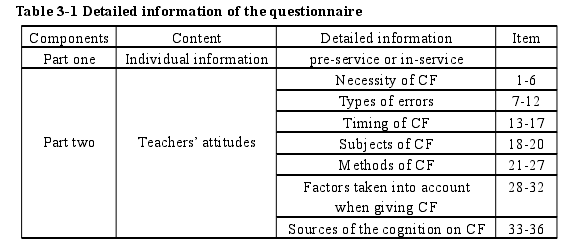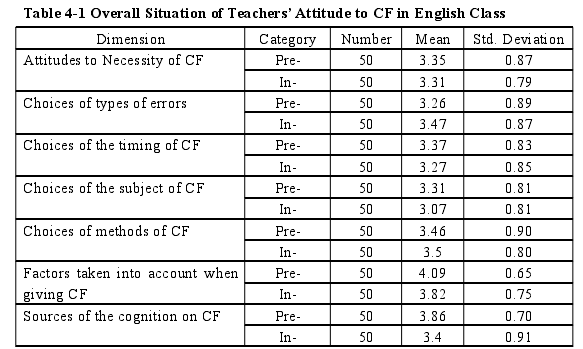本文是一篇英语毕业论文,本研究的主要发现如下。最重要的是,职前和在职教师对CF的态度呈现出一种平衡状态,即他们对某些方面持积极态度,而对其他方面持消极态度。就CF的必要性而言,大多数职前和在职教师都表现出积极的态度,认为有必要纠正学生的错误。
Chapter 1 Introduction
1.1 Background of the Study
The sixth part “Implementation Suggestions” of English Curriculum Standards forOrdinary Senior High Schools (version 2017) states that “in order to promote teachingand learning through assessment, teachers should appropriately and properly handle therelation between them (2017: 77). ” Specifically, teacher’s feedback is an important wayof assessment. According to the purpose of the evaluation activity and the students’characters, teachers can choose the timing of error correction. Feedback should focus onthe meaningful interaction between students and teachers so as to promote students’high-level thinking and cultural consciousness. Teachers shouldn’t give right or wrong orgood or bad evaluation in a hurry, instead, but to create opportunities for students to makeself-reflection and self-regulation (Ministry of Education of the People’s Republic ofChina 2017).
Feedback is significant in English teaching, which can be divided into positivefeedback and negative feedback (Nunan 1992). Negative feedback also refers tocorrective feedback (henceforth CF), which is a response of teachers to students’ errors(Ellis 2006). In developmental stages of English learning, it is unavoidable that learnersmake different kinds of linguistic errors in an effort to use the target language. In terms ofteachers, their belief in language learning and teaching will have impact on their attitudetoward learners’ errors and thus affect their ‘corrective reactions’ (Chaudron 1986). Thesignificance of errors exhibits in the language learning process, as indicators suggesting towhat extent the language learners have mastered the target language and in what aspects they are in need of help (Corder 1967). Upon the occurrence of linguistic errors, theappropriate way of treating them will greatly facilitate learning; otherwise, theinappropriate way will hinder learning. It is of great importance for language teachers tocorrect students’ errors appropriately. Thus, ‘whether to correct learners’ errors’ and ‘howto correct errors’ become the focus of their attention. Correcting language errors is notonly necessary, but also very helpful in that it can help learners make cognitivecomparison, adjust assumptions, and accelerate the absorption of language knowledge(Mackey & McDonough 2006). Therefore, the importance of CF is greatly highlighted.
.................................
1.2 Purposes and Significance of the Study
This study intends to investigate and compare the attitudes to CF in high schoolEnglish teaching between pre- and in-service English teachers. To be specific, the studyfocuses on two purposes. For one thing, this study investigates English teachers’ attitudeto CF from seven aspects, including necessity of CF, types of error, methods of CF, timingof CF, subject of CF, factors taken into account when giving CF and the source ofcognition on CF. For another, this paper analyzes the differences between the attitudes ofthese two groups of teachers to CF and explores the factors affecting the different attitude,which can deepen the understanding of pre- and in-service English teachers on CF, andprovide advice for the future training of pre-service teachers, and enhance theprofessional development for in-service teachers. Through these two purposes, both twogroups of English teachers master how to deal with learners’ errors.
In addition, the study has significance in both theoretical and practical aspects.Theoretically, first, the study enriches the research subjects and the field of CF in seniorhigh school English teaching, making it not only limited to error research, but also addingpre-service teachers as the research subjects and comparing with in-service teachers.Second, this study studies CF of pre- and in-service English teachers, which involvesteachers’ attitudes together with their practices. The results can enrich the theories ofpre-service and in-service teachers’ professional development. As for practicalsignificances, for one thing, the study involves a study of teachers’ methods of CF, whichis helpful for teachers to find a more effective way for error correction so as to improveCF efficiency. At the same time, teachers can better pay attention to students’ preference on CF and build a good relationship between their students so as to achieve effectiveteaching. For another, the comparative analysis of CF between pre- and in-service Englishteachers can strengthen professional development of both groups of teachers. To bespecific, it can not only provide reference for pre-service teachers to get on the teachingpost, but also provide suggestions for in-service teachers’ CF practices. One thingdeserves attention is that the comparison between these two groups of teachers is not fortelling people which group is right and which group is wrong.
.................................
Chapter 2 Literature Review
2.1 Corrective Feedback
2.1.1 Error and Its Classification
Error is part of the deviation from the correct expression when language learners useand produce the target language, and it is also an unavoidable matter in their learningprocess. When it mentions the definition of ‘error’, there are different views fromdifferent perspectives.
Some researchers provide the definition of error from the aspect of misuse ofgrammar item. Burt & Dulay (1974) name errors as ‘goofs’, meaning a perceivabledeviation from the correct grammar rules of native speakers. What else, it is hard forlearners to correct these errors by themselves. Chun et al. (1982) and Richards et al. (1992)point out that errors refer to the misuse of a language item by language learners.According to Liski & Puntanen (1983), errors occur when learners do not follow thetarget language.
Some researchers define ‘error’ according to students’ ability of self-correcting. Edge(1989) defines an error as a form of wrong utterances that students cannot repeat thecorrect answer despite the wrong part is told by teachers. James (1998) argues that onecharacteristic of errors is that learners cannot correct by themselves if they are notprovided with further prompts.
Some researchers draw the definition of error on the basis of students’ competence oftarget language. Brown (2000) mentions that errors are caused by the deficiency of abilityfor target language rather than carelessness or hesitation. Harmer (2006) believes thaterrors are portion of the inter-language of learners, who may temporarily speak or writesentences that deviate from the correct target language. Besides, according to Hu Yuezhu(2009), when language learners make inappropriate use of language due to incomplete orwrong language learning, they are considered to have made errors. In addition, DaiYanhong (2013) identifies errors as all language phenomena that do not conform to thestandards of the target language in classroom learning, which is attributed to theinsufficiency of knowledge in target language.
...................................
2.2 Related Research at Home and Abroad
2.2.1 Related Researches Abroad
Previous research focus on the five questions raised by Hendrickson (1978), i.e., 1)whether to do error correction; 2) which types of errors should be corrected; 3) who willcorrect students’ errors; 4) what is the timing for CF; 5) which methods of CF is mosteffective? Research concerning the above five aspects are shown as follows.
Whether to correct errors or not is much related to the attitudes to the necessity of CF,which includes not only teachers’ but also learners’ attitudes. Faqeih (2015) investigatesthe correlation between learners’ attitudes to CF and their learning inEnglish-as-a-second-language (ESL) experimental classroom. The results indicate that89 % of the participants prefer to have their errors corrected, and to certain extend, thereis a great significance of learners’ attitude in mediating their language accuracy.Roothooft & Breeze (2016) conduct a survey investigating the attitudes of 395 studentsand 46 teachers of EFL to oral CF. The study shows a mismatch between teachers’ andstudents’ beliefs on whether to correct errors: students are more eager to be corrected theirerrors than their teachers feel inclined to.
In terms of error types, two aspects are emphasized: 1) what kinds of errors areusually corrected; 2) what types of errors are corrected most. Chaudron (1988), uponclassroom observation, finds that errors in speech, content, and vocabulary are correctedmore often by teachers than those errors in pronunciation or grammar. In addition, there issignificant discrepancy between teachers in the frequency of error correction. Allwright &Bailey (1991) point out that not all language errors need to be corrected although errorsthat don’t accord with the rules of the target language in learning process are usually seen.In addition, learners have preference on types of errors, such as pronunciation errorsdespite that they often want all their errors to be corrected. Faqeih (2015) believes thatthere are 3 categories of errors that require correction.

Table 3-1 Detailed information of the questionnaire
.............................
Chapter 3 Research Design......................................26
3.1 Research Questions....................................... 26
3.2 Research Subjects................................................26
3.3 Research Instruments.........................................27
Chapter 4 Results and Discussion..................................32
4.1 Results of the Questionnaire...........................................32
4.1.1 Overall Situation of Pre- and In-service English Teachers’Attitudes to CF...............32
4.1.2 Differences on Pre- and In-service English Teachers’Attitude to CF.........43
Chapter 5 Conclusion..................................................56
5.1 Major Findings and Summary...................................56
5.2 Implications for Teachers’ Training and Development............................. 58
Chapter 4 Results and Discussion
4.1 Results of the Questionnaire
To answer the first two research questions, questionnaires are conducted toinvestigate pre- and in-service English teachers’ attitudes to CF, in which, their differentattitudes to CF are discussed as well. To get a clear picture of English teachers’ attitudesto CF, descriptive statistics are analyzed in details and the results are elaboratelypresented in the tables below.
4.1.1 Overall Situation of Pre- and In-service English Teachers’Attitudes to CF

Table 4-1 Overall Situation of Teachers’Attitude to CF in English Class
Table 4-1 displays seven dimensions of English teachers’ attitudes to CF in seniorhigh schools. As shown above, the mean value of the whole questionnaire for pre-serviceEnglish teachers is 3.53, meanwhile that for in-service English teachers is 3.41, and thestandard deviations are 0.81 and 0.83 respectively.
.....................................
Chapter 5 Conclusion
5.1 Major Findings of the Present Study
This study tends to investigate and compares pre- and in-service teachers’ attitude toCF of senior high school English classrooms as well as factors affecting their differentattitudes. The major findings of the present study are presented below.
Above all, the attitude of pre- and in-service teachers to CF exhibits a balancedsituation in that they hold a positive attitude to some aspects whereas a negative attitudeto other aspects. In terms of necessity of CF, most of the pre- and in-service teachersreveal a positive attitude, believing it’s necessary to correct students’ errors. However,they don’t think it’s appropriate to correct all errors, with a major consideration ofprotecting students’ self-esteem. Regarding types of errors, most pre- and in-serviceteachers believe that phonetic, pragmatic and communicative errors deserve correction themost. As for timing of CF, both pre- and in-service teachers believe it’s most appropriateto correct errors after students’ utterances or after the current activity in order to ensurefluency. As to subjects of CF, most pre- and in-service teachers favor student’self-correction/ peer correction the most though they value teacher correction. Withrespect to the methods of CF, both pre- and in-service teachers believe that they will adoptdifferent methods of CF into teaching. They regard recast, repetition and elicitation as themost effective for these three are conductive to students’ autonomous learning.Concerning ‘factors taken into account when giving CF’, both groups of teachersemphasize more on students’ character and English proficiency. Among the sources ofcognition on CF in this study, teaching practice is shown to be the most primary one.
reference(omitted)
